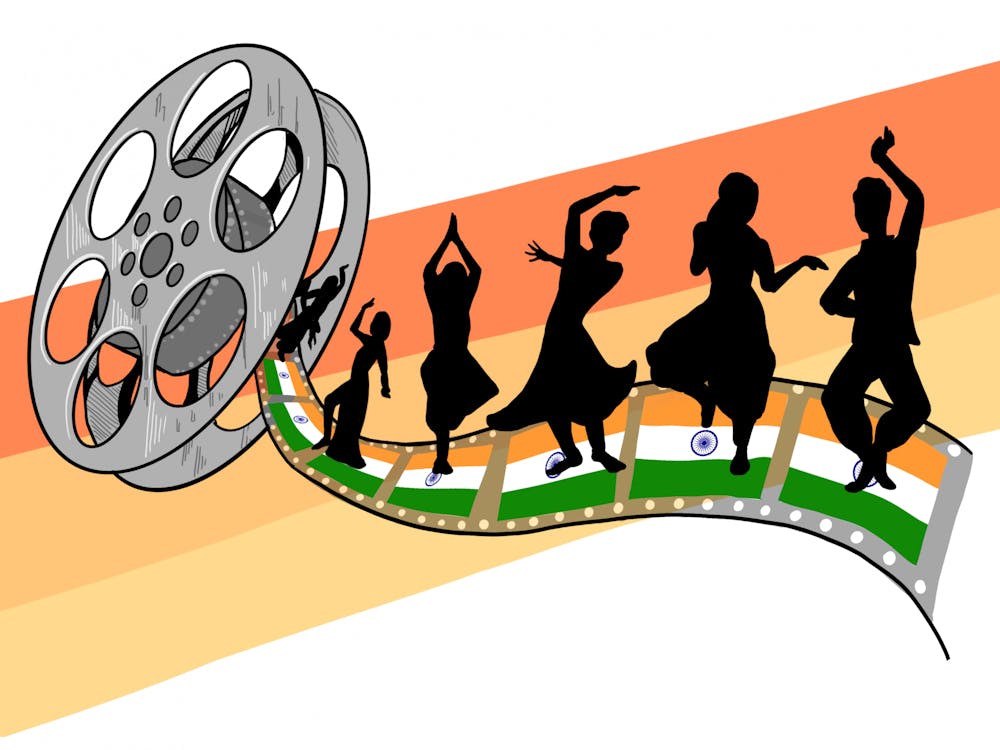When I was a child, my family didn’t have cable. When we wanted to watch something together, we’d pull out the DVD that sat under the television throughout my childhood, unceremoniously kept in a white paper sleeve with a handwritten title on the top: Dilwale Dulhania Le Jayenge, one of the most popular Bollywood movies ever made.
For years on end, I’d watch Dilwale Dulhania Le Jayenge at least once a week. The Bollywood movie with the longest theatrical run of all time, it was emblematic of Bollywood in the 1990s and early 2000s. It's an epic romantic drama starring Shah Rukh Khan and Kajol—two of the biggest stars in Indian cinema. There were lush scenes shot in three different countries: beautiful people staring into each other’s eyes, saris blowing in the wind. Over three hours long and including some of the most iconic outfits and songs of the era, Dilwale Dulhania Le Jayenge was both heart–wrenchingly romantic and dramatically campy. It was impossible not to be sucked into the overwhelming drama of it all.
The Indian films of my generation were the romantic musicals that defined the 1990s and early 2000s. Filled were filled with huge dance sequences, gorgeous songs, violent fight scenes, and exquisite romantic arcs, they are pure spectacle. And yet, there was rarely a single kiss to be found.
It’s important to understand that Bollywood isn’t a genre. It’s an industry—a cinematic force in its own right. It spans decades and genres and inevitably changes over time. Critically acclaimed films with iconic actors and classic quotes littered the films of the early to mid–20th century. Though many of the most popular recent films share common conventions of the genre, they vary in scope and story.
There's something so dramatic and pure about what we grew up watching—the sheer emotionality of it all. Magic filled these movies, sometimes quite literally. Think stories of lovers united, lovers killed, brothers who hated each other and died for each other, the brutal depths of both vengeance and devotion, and even aliens and superheroes. Bollywood relished in swelling emotions, never hiding away from close shots of people in love or anguish. There was something pure and refreshing about watching men and women so deeply submerged in their own emotions. Everything was music in every sense of the word; everyone fell in love at first sight. Sure, the musical numbers might have been unrealistic and overly coordinated, but showcased how talented our stars were—triple threats who could dance and act and lip–synch. Consequently, we crushed on and rooted for them.
When I meet international students from India or Pakistan at Penn, they tell me they these films are outdated and campy, filled with overused storylines and bad acting. But for those of us who grew up outside of our cultural homelands, sharing in our parents’ favorite films, actors, and songs bound us together. They became our conversation starters, our dance songs, and our sleepover movies. They shaped our childhoods, our cultural pride, and our notion of love and relationships in an era where so many of our parents had arranged marriages.
These films may have been campy, but they were so genuine to us as children. Love was fast and enduring, never overshadowed by any obstacle or conflict. Beyond that, these films were actually beautiful—forces of cinema equal to any movie being made in Hollywood. They were compelling and well–written, and have endured in our collective memory as classics, because they affected us as all good cinema should. They made us cry, and laugh and love as children and as adults.
I grew up on these films; I listened to classic Bollywood songs on the car radio during every drive. The tinny, charming songs of the 1950s, reminiscent of lovers skipping in the rain, their eyes meeting for the first time, all the way to the more modern, upbeat dance songs with strong beats and heavy baselines. I didn’t know anything about Hollywood films or actors, and it’s still a huge gap in my general knowledge. I loved these actors, who looked like me and spoke like me, who created a special world for me to live in.
These days, I watch fewer Bollywood films. The new wave of Indian cinema has fresh, young stars and darker, more realistic films. Modern Bollywood movies have verged toward grittier urban crime thrillers and dark comedies with more down–to–earth storylines. Though most are still musical dramas, they aren’t musicals in the way that western audiences may think.
I’m sure if I rewatched Dilwale Dulhania Le Jayenge now, I’d recognize its problematic aspects—in the way romantic comedies from the 80s and 90s tend to be problematic no matter where they’re made—but I’d still feel the same swell of emotions. I’d know the words to all the songs. I’d watch the protagonists annoy each other and spend time with each other and eventually fall in love with each other. Shah Rukh Khan and Kajol would be frozen in time, their epic love story spanning the years of both their lives and mine.

